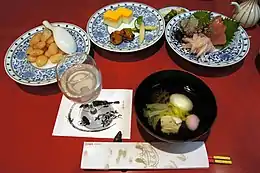
Shippoku (卓袱) is a Japanese culinary style that is heavily influenced by Chinese cuisine.[1][2] It has been described as a fusion cuisine and as a "hybrid cuisine" that combines elements of European, Chinese and Japanese cuisines.[3][4] Meats used in shippoku cuisine include fowl, fish, and game meats. Sake typically accompanies shippoku dishes.[5] The shippoku style of service typically includes several small dishes that comprise a full meal.[6]
Etymology
"Shippoku" is a Japanese word that means "table cloth."[lower-alpha 1]
History
Shippoku cuisine originated from Chinese immigrants to Nagasaki, Japan during the Edo period,[5] which occurred from 1603 to 1868. Nagasaki was the only place in Japan where foreigners (Portuguese, Dutch and Chinese) were allowed to reside during the "centuries of seclusion."[5] During the eighteenth century in Japan, the popularity of Chinese cuisine increased among Japanese intellectuals, and restaurants that focused upon shippoku and fucha cuisines, a vegetarian cuisine also influenced by Chinese cuisine, emerged.[5]
Shippoku cuisine remains a specialty of Nagasaki.[2]
See also
Notes
References
- ↑ Shurtleff, W.; Aoyagi, A. (1975). The Book of Tofu: Food for Mankind. The Book of Tofu. Autumn Press. p. 120. ISBN 978-0-394-73431-6. Retrieved April 16, 2017.
- 1 2 Nishiyama, M.; Groemer, G. (1997). Edo Culture: Daily Life and Diversions in Urban Japan, 1600-1868. THE NIPPON FOUNDATION. University of Hawaiʻi Press. p. 146. ISBN 978-0-8248-1850-0. Retrieved April 16, 2017.
- ↑ Cwiertka, K.J. (2006). Modern Japanese Cuisine: Food, Power and National Identity. University of Chicago Press. p. 94. ISBN 978-1-86189-298-0. Retrieved April 17, 2017.
- ↑ Ejeas. Volume 2. Brill. 2003. p. 95.
- 1 2 3 4 History Of Japanese Food. Taylor & Francis. 2014. p. 243. ISBN 978-1-136-60255-9. Retrieved April 16, 2017.
- ↑ Leventer, L. (1996). Fodor's Japan: the complete guide with the best of Tokyo, Kyoto and old Japan. Fodor's Gold Guides. Fodor's Travel Publications. p. 442. ISBN 978-0-679-03035-5. Retrieved April 17, 2017.
- ↑ Japanese inn & travel: illustrated. Eibun Nihon etoki jiten. Japan Travel Bureau. 1990. p. 182. Retrieved April 17, 2017.
External links
 Media related to Shippoku cuisine at Wikimedia Commons
Media related to Shippoku cuisine at Wikimedia Commons